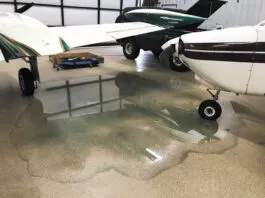Using RNAV/RNP
In 1957 the Soviet Union launched Sputnik, the first man-made satellite. The American psyche was troubled by the potential of this technological second place. This planted the seeds of one of Americas greatest military and technological innovations-GPS.
Driving All Night
About the only thing I personally know about Lincoln, Nebraska is a Dennys off Interstate 80. In my moderately delinquent youth, I helped a friend who couldnt afford a move from Connecticut to Colorado by renting a truck for local use one Thursday afternoon, disconnecting the odometer, round tripping across two time zones, and reconnecting it in time to log 30 miles before returning the truck Monday morning.
More Weather Radar
In our last issue, we talked about the building blocks of weather radar-how it was developed, the basics of radio waves, problems with radar sampling, and the important differences between composite and base reflectivity. If you havent read that, I highly recommend you do so to get a good grounding in radar fundamentals. In this issue well take that knowledge and teach you a bit about interpretation.
On The Air: October 2017
This August, just before the solar eclipse passed through the U.S., pilots from all over Utah flocked to southern Idaho into the zone of totality. The tower at Ogden Airport was busy, with a single controller handling tower and ground frequencies. As I taxied to the departure runway, several pilots called for clearances.
Working the Problem
From reading Hadfields autobiography An Astronauts Guide to Life on Earthand listening to various interviews online, its clear Hadfield is no stranger to unexpected problems. From a seagull strike in an F/A-18 Hornet fighter at 500 knots a mere 50 feet above the water, to temporarily going blind during his first spacewalk because of contamination in his helmet, he has faced some unique situations.
Multiple Approaches
Even after a couple hundred hours behind my Garmin GTN 650, there are still things I struggle to do properly. Chief among those is flying multiple approaches. Sure, we mostly have to do that in practice, but if you miss at a busy airport or the winds change after youve set up, you might find yourself needing to plug in that second approach, or third. If you were like me, youd get things hopelessly bollixed up before you just cleared the flight plan and started over.
Not Quite Up With the Times
The FAA, it is said, lags technology-sometimes significantly. These pages have been sprinkled with examples over the years. One recent example was in Jeff Van Wests article, A Bit Over Ninety, which appeared just last month.In that article, Jeff touched on the protected airspace for a turn at a fix. Before area navigation, all airways and procedures were designed expecting us to pass over the fix, suddenly realize that fact, and then turn to intercept the outbound course.
Briefing October 2017
Flight Design, based in Germany, has long held a top spot in deliveries of light sport airplanes in the U.S., but it has been in receivership in Germany since February 2016. The company announced in July it now has new owners, Lift Air, from Eisenach, Germany. I am glad that we are able to maintain the know-how of one of the worlds market leaders in the light aircraft sector and to secure it with a well-funded investor, said Knut Rebholz, insolvency administrator. The company will now be called Flight Design General Aviation GmbH. Tom Peghiny, president of Flight Design USA, told AVweb hes thrilled with the news.
Readback October 2017
The absolute best bang for the buck in charting is via a tablet and app as youre using. You didnt mention your transponder, but if youve got a new Garmin GTX 345, youve already got some connectivity between the iPad and GNS430W. Otherwise, you might consider a Flightstream 210 for that connection to exchange a lot of data between tablet and navigator.
Briefing: September 2017
Icon started to deliver airplanes to customers in June, and let them take them home and fly them wherever they want, the company said in its annual newsletter. The first deliveries went to owners in Seattle, Montana and California. To support these A5s, Icon said it trained authorized maintainers at their home airports. We are continuing to grow the third-party partner network to service upcoming deliveries that arent near factory service centers, currently in Vacaville and Tampa, Icon said. The company also said it has trained more than 125 pilots at its two Icon Flight Centers, and added that it hopes to deliver 15 more aircraft by the end of this year and ramp up to 200 deliveries in 2018.
Readback: September 2017
I submitted a PIREP yesterday that didnt get disseminated properly. Not only did it not show up during the 1.7 hours left in the flight, it wasnt listed when I checked after landing on the aviationweather.gov/adds web site for PIREPs in the previous eight hours. However, after submitting an inquiry about this to Lockheed Martin, it showed up the next morning (about 20 hours after the flight).
A Bit Over Ninety
It started with a reader question about the RNAV (GPS) Y Rwy 28L at Monterey, CA (KMRY). The question seems simple on the surface: There is a feeder from the SNS VOR to HIXAR on a heading of 146 degrees. The inbound course is 235, meaning an 89-degree turn is required. Are you required to fly the HILPT? AIM 5-4-9 (5) and (6) seem to say yes, but 5-4-5 (8) seems to say a turn from the feeder of less than 90 degrees is implicitly NoPT.














